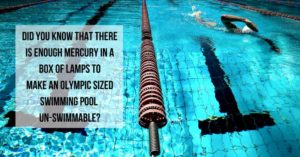 In Alberta, unlike in BC and Ontario, recycling lightbulbs is not part of our province’s legislation. This is an issue, as bulbs, especially the type used in large commercial buildings (referred to as lamps in this post), contain a large amount of mercury. For each case of lamps, there is enough mercury to make an Olympic sized swimming pool toxic and un-swimmable. For metal-halide, this amount is increased. In fact there is 10x more mercury in metal-halides than there is in fluorescents. If one was to just throw their lamps (and bulbs) in the garbage, this mercury would eventually leach into the ground and become a large environmental issue.
In Alberta, unlike in BC and Ontario, recycling lightbulbs is not part of our province’s legislation. This is an issue, as bulbs, especially the type used in large commercial buildings (referred to as lamps in this post), contain a large amount of mercury. For each case of lamps, there is enough mercury to make an Olympic sized swimming pool toxic and un-swimmable. For metal-halide, this amount is increased. In fact there is 10x more mercury in metal-halides than there is in fluorescents. If one was to just throw their lamps (and bulbs) in the garbage, this mercury would eventually leach into the ground and become a large environmental issue.
To get a little more specific about what this means for building operators, a standard four foot long T8 fluorescent bulb has a mercury vapor concentration of 5 mg/118 in3 . Think about how many tubes you have in your building – with an average of 500 tubes per floor, and with 20 storeys (or over for some buildings), it adds up quite quick.
This is why programs like the BOMA BEST® Certification or the LEED program make the recycling of your lamps one of their ‘checklist’ items to receive environmental standards certification. But how does one go about doing this? Especially when these certification programs require a guarantee from a recognized source that they have been recycled properly?
There is no good system in place for lamp recycling. Consumers and residential property owners can recycle bulbs at Home Depot or Ikea, but these programs are not designed for the high volume that comes with commercial buildings’ bulb recycling needs. As a result of the lack of provincial and municipal recycling options, it falls to private companies to recycle fluorescents, metal-halides, and ballasts. When looking for a company to recycle your lamps, deal with an institution that can handle scale and makes it easy for the building operators to use. Some programs can be hard to work with and result in low usage or extra unnecessary work, and we all know that building operators have lots on their plate.
A strong recycling program can also bridge the gap between a building’s operators and the management part of the team. Lamp recycling mandates from “above” add extra work into a building operator’s already tight schedule. So, a well thought out and easy to use recycling program from a reputable vendor can help mitigate the time drain issue, and is also able to give certification and transparency as to where the materials are being recycled.
A hidden benefit of recycling your lamps is the fact that it can attract tenants. Some people considering taking space in your building may be more energy conscious, or be operating under ‘green’ mandates, and the fact that you have a certified recycling program in place makes your building more attractive than the ones they are considering that don’t.
Another little known benefit is that recycling your lamps could help you or your tenants receive financial assistance or rebates from the government. Some Grants and rebate programs require proof of recycling to receive the funding.
One last thing I would like to touch on carbon footprints. At the Paris Talks in late 2015, Canada agreed to reduce the country’s carbon footprint and transition to a low carbon economy. As new regulations are announced to that end regarding carbon and carbon offsetting, it is important to note that recycling your bulbs/lamps will be a way your business can comply with these rules.
Latif Jamani, President of Calgary Lighting Products